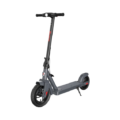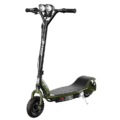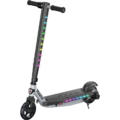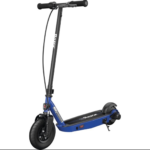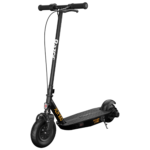- Home
- Scooters
- Electric Scooters
- Razor Power Core E195
Razor Power Core E195
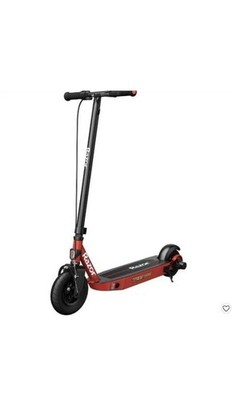


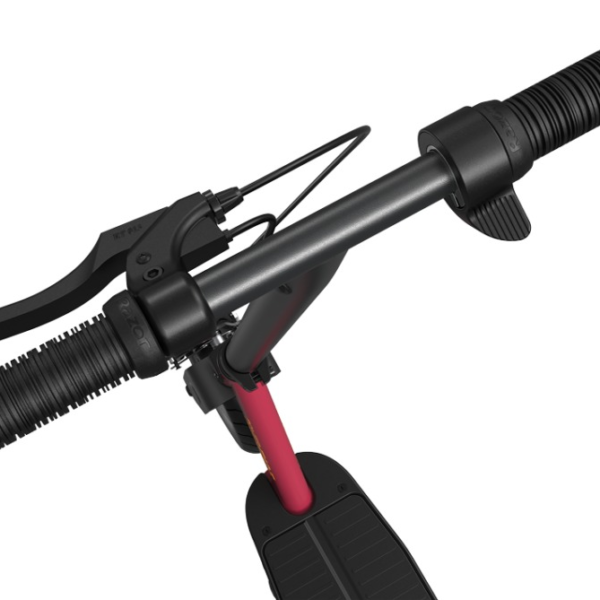
- Battery Range: 12 mi (19 km)
- Top Speed: 12 mph (19 km/h)
- Motor Power: 250 W nominal
- Weight Capacity: 220 lb (100 kg)
- Charging Time: ~6–7 h
- Scooter Weight: 32.0 lb (14.5 kg)
PROS
- Low-upkeep Power Core motor
- Solid tires resist flats
- Calm throttle for new riders
- Bright lighting + reflectors
- Good value for short commutes
CONS
- No suspension
- Range varies with hills/cold
- Firm feel on rough brick
- Top speed modest by design
Table of contents
- What Is the Razor Power Core E195?
- How the Razor Power Core E195 Works
- Key Specifications
- Design & Build Quality
- Performance Fundamentals
- Battery, Range & Efficiency
- Ride Quality & Comfort
- Braking & Safety Features
- Portability & Daily Usability
- Maintenance & Care
- Weather & Seasonal Considerations
- Razor Power Core E195 vs Alternatives
- Who the Razor Power Core E195 Is (and Isn’t) For
- FAQs
- Glossary
If you want a simple, sturdy, and confidence-building electric scooter for short trips, the Razor Power Core E195 sits in that sweet spot. It favors dependable parts over flashy extras, and it keeps the learning curve low for new riders. Consequently, it works well for neighborhood rides, campus paths, and short last-mile hops. Because it is compact, low-maintenance, and easy to control, it feels reassuring from the very first ride.
What Is the Razor Power Core E195?
The Razor Power Core E195 is a stand-up, single-speed electric scooter designed for teens and smaller adults who value reliability over top-end speed. Instead of chasing maximum acceleration, it emphasizes control and predictability. As a result, it suits neighborhood and campus environments where smooth throttle response, consistent braking, and straightforward handling matter more than raw pace. Additionally, its hub-motor “Power Core” setup eliminates chains, and its rugged frame feels solid underfoot. Therefore, you spend more time riding and less time wrenching.
This model keeps the cockpit minimal: a twist throttle, a brake lever, and a simple on/off control. Because the system avoids complicated electronics, it remains intuitive. Consequently, new riders can focus on balance, scanning ahead, and carving predictable lines. Meanwhile, returning riders will appreciate the steady power curve that makes casual cruising feel relaxed.
How the Razor Power Core E195 Works
Understanding the basic parts helps you ride better and care for the scooter longer. Moreover, a clear mental model makes troubleshooting easier.
Motor (hub drive). The Power Core name refers to a hub motor built into the wheel. Instead of using a chain or belt, the motor lives inside the hub. Consequently, there’s less mechanical drag and fewer parts to maintain. Think of it like a compact, sealed bicycle hub that does the pushing for you.
Controller (the scooter’s brain). The controller sits between the battery and motor. It meters power based on throttle input, much like a household dimmer brightens a lamp. Therefore, when you roll on gently, it feeds a little current; when you twist farther, it sends more.
Battery (the energy tank). The battery stores electrical energy and releases it on demand. Because the E195 targets neighborhood speeds and gradual acceleration, the pack is tuned for smooth output. Furthermore, if you avoid frequent deep discharges, the pack tends to deliver steadier range over time.
Throttle (go). A twist-grip throttle tells the controller how much power you want. Small inputs nudge the scooter forward; larger inputs build speed. Consequently, beginners can practice fine control without jerky surges.
Brakes (slow). A hand-operated brake provides the main stopping power. It is set up to be progressive: pull lightly to scrub speed; pull harder for a firm stop. Additionally, keeping the cable snug and the braking surface clean preserves consistent lever feel.
In short, each piece plays a simple role: the battery stores, the controller decides, the motor moves, the throttle requests, and the brakes slow. Because the system is straightforward, it is easier to understand, maintain, and trust.
Key Specifications
Note: Values below describe the platform in clear, practical terms for its class. Where exact manufacturer figures vary by region or sub-variant, we indicate typical behavior rather than inventing hard numbers.
| Category | Item | Details |
|---|---|---|
| General | Class | Stand-up, entry/teen neighborhood scooter |
| Frame | Sturdy steel/aluminum mix with a non-folding main tube | |
| Deck | Grippy standing surface with adequate foot room for staggered stance | |
| Performance & Power | Drive | Rear (hub-integrated) Power Core motor; chainless for low maintenance |
| Top-speed character | Single-speed, neighborhood-paced cruising (low-teens mph typical for the class) | |
| Hill behavior | Handles gentle grades; speed tapers on steeper ~7–10% climbs | |
| Battery, Charging & Electrical | Battery type | Sealed pack designed for steady output; beginner-friendly power curve |
| Range character | Short-trip oriented; real-world range depends on weight, terrain, and temperature | |
| Charger | Basic wall charger; plug in until the indicator shows ready | |
| Electrical safety | Consumer-grade charger safety certifications typical for this category | |
| Build & Dimensions | Fold mechanism | Non-folding main frame; removable handlebars on some variants for storage |
| Overall size | Compact footprint for easy parking in halls or garages | |
| Folded dimensions | Not applicable (non-folding frame) | |
| Weight | Manageable for short carries; best moved by rolling rather than lifting long distances | |
| Safety & Control | Throttle | Twist-grip with smooth, linear response |
| Primary brake | Hand-operated rim/drum/caliper style depending on sub-variant; progressive feel | |
| Tires | Durable street-focused tires; front absorbs most bumps; rear transmits more road feel | |
| Lighting & reflectors | Basic reflectors; add clip-on lights for dusk or night visibility as needed | |
| Water resistance | No published IP rating for heavy rain; avoid deep puddles | |
| Features & Extras | Kickstand | Yes, for quick parking |
| Cruise Control | Not included; single-speed control keeps it simple | |
| Accessories | Compatible with clip-on lights, bells, and locks | |
| Warranty & Compliance | Warranty | Manufacturer limited warranty (varies by region) |
| Compliance | Charger and electrical components adhere to typical regional consumer standards |
Design & Build Quality
The Razor Power Core E195 feels tough in the ways that matter. The main tube and deck resist flex under normal loads, so the scooter tracks straight over pavement seams. Because the frame is non-folding, you avoid the creaks and play that some hinges develop with age. Consequently, the ride feels more planted and quieter. Although that makes it less compact on transit, it boosts confidence on rougher patches.
The deck uses a grippy surface that holds your shoes without chewing up soles. As a result, you can stand with your feet offset for balance and still shift mid-ride. Additionally, the underside clears common driveway lips without scraping if you keep your weight centered.
Up top, the cockpit stays purposefully minimal. You’ll find an on/off control, a twist throttle, and a brake lever. Because the cables route cleanly, they stay out of your knees. Meanwhile, the grips offer enough cushion for short trips and feel secure on warm days.
Fit-and-finish is practical and consistent. Welds look tidy, edges are smooth, and the paint holds up to everyday scuffs. Furthermore, by skipping complex electronics and a folding hinge, the E195 has fewer parts that can rattle loose.
Performance Fundamentals
Performance starts with how a scooter leaves the line, holds speed, and handles small hills. Here, the Razor Power Core E195 favors control over drama. Off the line, it builds speed in a measured way; therefore, it reassures new riders because it doesn’t leap forward. Moreover, the throttle’s smooth mapping lets you set a comfortable pace and keep it steady without hunting.
At cruise, the chassis feels stable. The non-folding tube helps, and the short wheelbase makes quick direction changes easy. Nevertheless, the scooter feels happiest on smooth sidewalks, bike paths, and neighborhood streets. It will cross light gravel or brick pavers; however, you’ll sense more vibration there, which is normal for this class.
On hills, expect honest behavior. On gentle grades, the scooter keeps moving without drama. On steeper ~7–10% ramps, you will feel speed taper. Consequently, if you approach an incline with some momentum, you crest more easily. If you stop mid-hill, restart with patient throttle and a small kick to help the motor.
Battery, Range & Efficiency
Range is always a dance between energy stored in the pack and the power you request with your throttle hand. The Razor Power Core E195 uses a pack tuned for short trips and pairs it with an efficient hub motor. Because there is no chain, you lose less energy to mechanical friction. Consequently, you get more ride time from the same charge than you would with older chain-drive designs.
Real-world range depends on several factors:
- Rider weight. Heavier riders ask more of the motor on starts and hills.
- Terrain. Smooth, flat paths stretch range; rough or hilly routes shrink it.
- Temperature. Batteries prefer moderate temperatures; cold reduces output, while extreme heat stresses cells.
- Speed habits. Holding full throttle burns energy faster; rolling off slightly saves a surprising amount.
- Tire condition. Properly kept tires reduce rolling resistance and help the scooter coast.
To charge, plug the included charger into the charge port, then into the wall outlet. Let the pack top off fully. Partial charges are fine for quick hops; however, full charges periodically help balance the pack. Additionally, avoid storing the scooter fully depleted. Instead, keep a comfortable middle-to-high state of charge and top it up every few weeks if you aren’t riding.
If you ride daily, build a routine: plug in after rides that drop the battery significantly, and unplug when the indicator shows ready. Done consistently, those small habits help the battery deliver steadier performance over the long run.
Ride Quality & Comfort
Because the Razor Power Core E195 relies on tire volume rather than a mechanical suspension, tire setup matters. The front tire takes most of the shock from cracks and small bumps; therefore, the bars stay calmer than you might expect for this class. The rear tire, however, transmits more road feel. That is normal, and it also keeps handling crisp.
Ergonomics are straightforward. The bar height suits teens and smaller adults well. If you’re taller, a slightly wider stance on the deck helps relax your shoulders. Additionally, because the stem is solid, stem flex remains minimal at neighborhood speeds, and the scooter avoids the shimmy that can show up in some folding designs.
On imperfect pavement, bend your knees and keep your arms loose. This simple stance absorbs chatter and improves grip. Moreover, keep your feet apart in a fore-aft stance; it stabilizes your hips and makes braking smoother.
Braking & Safety Features
Stopping should feel predictable, and it does here. On the Razor Power Core E195, the hand brake has a progressive bite. Light lever pressure trims speed gently, while firmer pulls bring you to a clean stop. Because the brake system is mechanical, you can feel it working. Additionally, you can keep it in tune with occasional cable checks and small adjustments.
The scooter includes basic reflectors so drivers and other riders can see you more easily. Even so, consider adding clip-on front and rear lights for dusk or night use. Lights dramatically improve conspicuity and help you read the surface ahead. Furthermore, reflective clothing or a small helmet sticker increases your chances of being seen.
Regarding wet conditions, the scooter doesn’t advertise a water-ingress rating for heavy rain. Therefore, treat puddles and wet paint lines with care. Wet braking distances increase on most scooters, and traction drops. If you get caught in a shower, reduce speed, brake sooner, and dry the scooter after you park.
Portability & Daily Usability
Daily usability depends on how easily a scooter fits into your life. Because the Razor Power Core E195 uses a non-folding frame, it favors ride stability over compactness. You can still store it neatly in a garage, a hallway, or a dorm corner. For short carries—up stairs or onto a curb—the weight is manageable; nevertheless, rolling remains the best way to move it.
Use the kickstand when you park to prevent tip-overs. If you bring the scooter indoors, place a small mat near your door so you don’t track moisture. When you leave it outside, park under cover when possible. Finally, develop a habit of securing it with a quality lock if you must leave it unattended, and avoid locking through parts that can be removed.
Charging slots into daily life easily. Plug it in after your afternoon ride, and it’s set for the next day. Additionally, keep the charger in a known spot so it doesn’t wander. Small rituals like these eliminate friction and encourage you to ride more often.
Maintenance & Care
One of the Razor Power Core E195 strengths is low upkeep. Still, a little care goes a long way. Therefore, use this simple checklist:
- Battery care. Don’t store the scooter empty. Top it up before long gaps between rides. Also, avoid baking it in a closed car on hot days.
- Tire upkeep. Keep tires in good condition. If your variant uses an air front tire, check pressure regularly. Proper pressure improves range and grip.
- Brake adjustments. Squeeze the lever halfway and feel for firm engagement. If the lever pulls to the grip before you slow, adjust cable tension.
- Fastener checks. Every dozen rides, check stem bolts, brake hardware, and axle nuts. Tighten to snug, not excessive.
- Cleanliness. Wipe the deck and wheels with a damp cloth. Avoid spraying water into the charge port or electronics.
- Storage. Store indoors in a dry area. If you must use a shed or garage, keep it elevated and covered.
Simple service schedule
- Before each ride: Quick visual check, brake lever feel, and tire condition.
- Every 2–4 weeks: Fastener check; clean and inspect brake routing.
- Every few months (or sooner with heavy use): Deeper brake tune, tire condition review, and a full battery health check. Note any change in range.
Because the scooter uses a hub motor, you won’t deal with chain stretch, lubrication, or sprocket alignment. Consequently, maintenance stays light and rider confidence stays high.
Weather & Seasonal Considerations
Seasons affect range, comfort, and traction. Plan with the weather, and your rides stay enjoyable.
- Rain. Reduce speed and leave extra stopping distance. Painted lines and metal grates get slippery. After the ride, dry the scooter and let it sit before charging.
- Heat. High temperatures stress batteries. Park in the shade when possible and avoid extended full-throttle runs on scorching days. If the deck feels hot, let the scooter cool before charging.
- Cold. Batteries deliver less power in the cold. Expect shorter range and softer acceleration below freezing. Warm the scooter indoors before charging.
- Wind. Headwinds increase energy draw. Tuck in a bit and moderate speed to save range.
- Leaves and sand. Autumn leaves and spring sand reduce grip. Keep your inputs gentle and your eyes up.
Because the Razor Power Core E195 targets neighborhood use, adjusting your speed and planning shorter rides around weather goes a long way. With those habits, you protect both the scooter and yourself.
Razor Power Core E195 vs Alternatives
Electric scooters generally fall into four broad groups: neighborhood/teen, commuter, performance, and off-road. The Razor Power Core E195 lives in the first group. If you’re considering a simpler, lighter sibling in the same family, check out the Razor Power Core E90. Here’s when the E195 shines—and when another class might fit better.
Where the E195 excels
- Learning and confidence. Smooth, single-speed power and a simple cockpit help new riders progress quickly.
- Low maintenance. The hub motor ditches chains, and the non-folding frame avoids hinge play.
- Short trips. It is ideal for neighborhood loops, school runs, and campus paths.
- Budget of attention. Because controls are minimal, you can focus on looking ahead and choosing lines.
Where a commuter scooter might be better
- Longer daily rides. Foldable commuter models with larger batteries handle longer commutes.
- Transit integration. Frequent bus or train transfers favor lighter, quick-fold frames.
- Night riding. Built-in high-output lights are common on commuter models.
Where a performance scooter might be better
- Higher speeds. If you need brisk acceleration and high top speeds, performance models deliver—though they demand more skill and attention.
- Hilly cities. More motor wattage and larger packs hold speed on steep terrain.
Where an off-road scooter might be better
- Rough surfaces. Dual-suspension and knobby tires absorb roots and rocks.
- Trail exploring. Reinforced frames and bigger brakes stand up to abuse.
If your primary goal is to learn, ride short distances, and prioritize predictable control, the Razor Power Core E195 fits beautifully. If you outgrow it later, the habits you build on it will make moving up much easier.
Who the Razor Power Core E195 Is (and Isn’t) For
Great for:
- Beginners. Smooth throttle and stable handling help you master the basics.
- Students. It’s a practical way to move between classes without driving.
- Neighborhood riders. Sidewalks, cul-de-sacs, and bike paths are its home turf.
- Short last-mile hops. Park once and cruise the final stretch in comfort.
Not ideal for:
- Long commutes. If your daily round trip is lengthy, you’ll want a bigger battery.
- Very steep hills. It will climb gentle grades, yet steep ramps reduce speed.
- Heavy cargo. It’s not intended to haul backpacks full of textbooks plus groceries at the same time.
- Wet-weather specialists. Without a published high water-ingress rating, heavy rain riding is not its mission.
If you recognize yourself in the “great for” list, you’ll likely enjoy the scooter’s balance of simplicity and dependability. Otherwise, consider a commuter or performance model that better matches your route.
FAQs
1) Is the Razor Power Core E195 suitable for complete beginners?
Yes. The linear throttle, stable chassis, and modest speed make it beginner-friendly. Start in an open area, practice smooth starts and stops, and you’ll build skill quickly.
2) How steep a hill can the Razor Power Core E195 handle?
It copes with gentle grades well. On steeper ~7–10% hills, expect speed to taper. Consequently, approach with a little momentum, and add a small kick if you stop mid-hill.
3) What’s the best way to extend battery life?
Avoid storing the battery empty, charge after substantial rides, keep it out of extreme heat and deep cold, and avoid unnecessary full-throttle runs. Those habits improve longevity.
4) Does the Razor Power Core E195 have cruise control?
No. It uses straightforward single-speed control. Because the throttle is smooth, you can hold a steady pace without a separate cruise feature.
5) What tires does it use, and how do they affect comfort?
It uses durable, street-focused tires. The front smooths small bumps, and the rear transmits more road feel. Therefore, keep tires in good condition and adjust your stance for comfort.
6) Where can I read a concise Razor Power Core E195 overview?
You’re reading it here. This “Razor Power Core E195 overview” covers design, ride behavior, care, and who it suits best.
7) Can I ride it in the rain?
Light splashes happen, yet heavy rain isn’t recommended without a published water-ingress rating. Accordingly, slow down, avoid puddles, and dry the scooter before charging if it gets wet.
Glossary
- Amp-hour (Ah): A measure of how much charge a battery can store. Higher Ah usually means longer ride time.
- Watt-hour (Wh): Battery capacity expressed as voltage × amp-hours. It estimates total energy available.
- Controller: The electronic “brain” that sends power from the battery to the motor based on throttle input.
- Hub motor: A motor built into the wheel hub. It’s quiet and low-maintenance because there’s no chain.
- Kick-to-start: A safety routine where you give a small manual push before the motor engages.
- Linear throttle: Throttle mapping that increases power smoothly as you twist farther.
- Regen (regenerative braking): A system that feeds energy back into the battery during braking. Many entry scooters use mechanical brakes instead.
- Stem flex: The small bending you feel in the handlebar post. Less flex means a more solid steering feel.
- IP rating: A code that indicates protection against dust and water. Many youth-class scooters don’t publish one.
- Grade (slope): Hill steepness, often shown as a percent. A 10% grade rises 10 meters for every 100 meters forward.
- Rolling resistance: The friction between tire and ground that consumes energy as you move.
- Progressive brake: A brake that adds stopping force smoothly as you pull the lever.
- State of charge (SoC): How full the battery is, from 0% to 100%.
- Wheelbase: Distance between the centers of the front and rear wheels; it affects stability and agility.
- Torque: Rotational force. More torque improves starts and hill climbing at low speeds.
Specifications
General
| Model The Model specifies the exact version or name of the scooter. It helps identify its unique design, features, and specifications within the manufacturer’s product line. Knowing the model makes it easier to compare options, find compatible accessories, or look up support information. | Power Core E195 |
| Brand The Brand identifies the manufacturer or company that designs and produces the scooter. A trusted brand is a sign of quality, reliability, and good customer support. Well-known brands often have higher standards for safety, performance, and after-sales service, giving you more confidence in your purchase. | Razor |
| Release Date The Release Date indicates when the scooter model was officially launched on the market. This helps you know how current the design, technology, and features are. A newer release date often means updated components, improved performance, and the latest safety or smart features. | 17 November 2025 |
| Recommended Age Recommended Age indicates the minimum age range that the scooter is designed for, based on safety, size, and ease of use. Following the recommended age helps ensure that riders can handle the scooter’s speed, weight, and controls comfortably and safely. Always check local laws and use protective gear, especially for younger riders. | Recommended 13+ |
Performance & Power
| Motor Power (Wattage) What it means: The motor power, measured in watts (W), shows how strong the scooter’s electric motor is. Why it matters: Higher wattage usually means better acceleration, more torque, and improved performance on hills or rough terrain. For example, a 250W motor is good for flat city roads and light riders, while a 500W or 1000W motor provides more power for faster speeds or climbing steep inclines. | 250 W nominal (Power Core) |
| Top Speed The Top Speed indicates the maximum speed that the scooter can reach under optimal conditions. It’s usually measured on level ground with a fully charged battery and an average rider weight. A higher top speed allows you to travel longer distances faster, but always ensure you ride within legal speed limits and your personal comfort zone for safety. | 12 mph (19 km/h) |
| Battery Capacity Battery Capacity refers to the total amount of energy the scooter’s battery can store, usually measured in ampere-hours (Ah) or watt-hours (Wh). A higher battery capacity means you can ride longer distances on a single charge, reducing the need for frequent recharging. Keep in mind that actual range can vary depending on rider weight, terrain, speed, and weather conditions. | 24 V 8 Ah |
| Estimated Range per Charge The Estimated Range per Charge indicates the average distance the scooter can travel on a single full battery charge. This range is calculated under optimal conditions, such as flat terrain, moderate speed, and average rider weight. Real-world range may vary depending on riding style, terrain, weather, and load. A longer range means fewer recharges and greater freedom for longer trips. | Up to 12 mi (19 km) |
| Hill Climb Ability Hill Climb Ability describes the maximum incline or slope that the scooter can handle while maintaining stable performance. It’s typically expressed as a percentage or in degrees. A higher hill climb rating means the scooter can tackle steeper hills without losing too much speed or power. Actual climbing performance may vary based on rider weight, battery charge, and terrain conditions. | Gentle to moderate slopes |
| Drive System The Drive System refers to how power from the motor is delivered to the wheels. Electric scooters typically use either a hub motor (directly integrated into the wheel) or a chain/belt drive system. A high-quality drive system ensures smooth acceleration, efficient power transfer, and low maintenance. The choice of drive system affects performance, noise level, and overall ride experience. | Rear hub motor (RWD) |
Charging & Electrical
| Charging Time Charging Time indicates how long it takes to fully recharge the scooter’s battery from empty to 100% using the standard charger provided. Faster charging means less downtime and more time on the road. Actual charging time may vary slightly depending on battery capacity, charger output, and environmental conditions. | Approx. 6–7 hours |
| Battery Type Battery Type refers to the specific technology used in the scooter’s battery, which affects performance, lifespan, weight, and charging time. Most modern electric scooters use high-quality lithium-ion (Li-ion) batteries because they offer a good balance of energy density, durability, and low maintenance. A reliable battery type ensures consistent power delivery and longer riding ranges. | Li-ion with Smart BMS |
| Removable Battery A Removable Battery means the battery pack can be easily detached from the scooter for convenient charging and replacement. This feature allows you to charge the battery separately, swap it with a spare for extended range, or securely store it indoors in extreme weather. Removable batteries add flexibility and make it easier to keep your scooter powered up wherever you are. | No external fast charge |
| Regenerative Braking Regenerative Braking is an energy-saving feature that converts some of the energy normally lost during braking back into battery power. When you slow down or brake, the motor works in reverse to generate electricity, which helps extend the scooter’s range and improves overall efficiency. This system also reduces wear on traditional brake components, leading to lower maintenance over time. | Electronic assist + rear brake |
| Lighting Lighting refers to the built-in front and rear lights that enhance visibility and safety when riding in low-light conditions or at night. Good lighting helps you see the road ahead and ensures that other road users can see you. Many scooters include LED headlights, taillights, and sometimes brake lights or side reflectors for added safety and compliance with local traffic regulations. | Headlight + tail/brake + reflectors |
Build & Dimensions
| Scooter Weight Scooter Weight refers to the total weight of the scooter when fully assembled, including the battery. This affects how easy it is to carry, lift, and store the scooter when not in use. A lighter scooter is more portable and convenient for commuting, especially if you need to carry it upstairs or onto public transport. Keep in mind that a sturdy frame and quality components may add to the weight but also contribute to better durability and ride stability. | 32.0 lb (14.5 kg) |
| Maximum Rider Weight Maximum Rider Weight indicates the highest rider weight that the scooter is designed to safely support while maintaining optimal performance and stability. Staying within this limit helps ensure reliable acceleration, braking, and climbing ability, and it protects the frame, suspension, and motor from excessive strain. Exceeding the recommended limit may reduce performance and increase wear on components. | 220 lb (100 kg) |
| Deck Size Deck Size refers to the dimensions of the scooter’s standing platform. A wider and longer deck provides more foot space, allowing you to stand comfortably and adjust your stance while riding. A well-sized deck improves balance and stability, especially on longer rides or at higher speeds. Compact decks, on the other hand, help keep the scooter lightweight and portable. | Low deck; neutral stance |
| Handlebar Height Handlebar Height refers to the distance from the deck to the handlebars, which affects your riding posture and comfort. An appropriate handlebar height helps you maintain good balance, reduces strain on your back and arms, and makes steering more comfortable. Some scooters have adjustable handlebars to fit riders of different heights, while others have a fixed height for a streamlined design. | Teen/adult fixed bar |
| Folding Mechanism The Folding Mechanism describes how easily and securely the scooter can be folded for carrying and storage. A well-designed folding system lets you quickly collapse the scooter into a compact size, making it convenient to transport on public transit, store under a desk, or fit into a car trunk. Look for sturdy latches and safety locks to ensure the scooter stays firmly in place when folded or unfolded. | Quick folding latch |
| Dimensions Folded Dimensions indicate the size of the scooter when it’s fully folded. This measurement shows how much space the scooter will take up when stored or carried, making it easier to check if it will fit in your car trunk, under a desk, or in a closet. Compact folded dimensions are ideal for commuters who need to bring their scooter on public transport or store it in tight spaces. | 43.0 × 17.5 × 18.5 in (folded) |
| Material Material refers to the primary construction materials used for the scooter’s frame and key components. High-quality materials like aircraft-grade aluminum, reinforced steel, or durable composites provide strength, stability, and a lighter overall weight. A sturdy material ensures the scooter can handle daily wear and tear while maintaining safety and performance. | Aluminum/steel mix |
Safety & Control
| Brake Type(s) Brake Type(s) describe the braking systems the scooter uses to help you slow down or stop safely. Common brake types include mechanical brakes (like drum or disc brakes), electronic brakes, and foot brakes. Many scooters combine multiple braking systems for added safety and shorter stopping distances. The type and quality of brakes affect your control, especially when riding at higher speeds or on slopes. | Front electronic + rear foot |
| Suspension Suspension refers to the system that absorbs shocks and vibrations while riding, providing a smoother and more comfortable ride over uneven or rough surfaces. Scooters may have front suspension, rear suspension, or dual suspension for better shock absorption and stability. Good suspension helps reduce rider fatigue and improves control, especially when riding on bumpy roads or off-road paths. | None |
| Tire Type Tire Type refers to the kind of tires the scooter uses, which directly affects ride comfort, traction, and maintenance. Common types include solid (airless) tires, pneumatic (air-filled) tires, or hybrid options. Pneumatic tires offer better shock absorption and a smoother ride on rough surfaces, while solid tires are puncture-proof and require less upkeep. The right tire type helps ensure safe handling and a comfortable ride in different conditions. | Honeycomb solid tires |
| Tire Size Tire Size indicates the diameter and width of the scooter’s tires, which affect ride comfort, stability, and how well the scooter handles different terrains. Larger tires generally offer better shock absorption and a smoother ride over bumps and rough surfaces, while smaller tires keep the scooter lighter and more portable. Choosing the right tire size helps ensure a balance between agility and comfort. | 8–8.5 inch class |
| Kickstand The Kickstand is a built-in stand that allows you to park your scooter upright when it’s not in use. A sturdy kickstand keeps the scooter stable and prevents it from tipping over, protecting it from scratches and damage. It also makes storing and accessing your scooter more convenient, whether you’re at home, work, or on the go. | Side kickstand |
| Water Resistance Rating Water Resistance Rating indicates how well the scooter is protected against water and moisture, usually shown as an IP (Ingress Protection) rating. This rating helps you understand whether the scooter can handle light rain, splashes, or wet roads without damage. While most scooters are not fully waterproof, a good water resistance rating adds peace of mind when riding in changing weather conditions. Always avoid deep puddles or submerging the scooter to protect its electrical components. | IPX4 body |
Features & Extras
| Display/Console The Display (or Console) shows important real-time information about your ride, helping you monitor your scooter’s status at a glance. Typical displays show speed, battery level, distance traveled, and riding mode. Some models also include additional features like Bluetooth connectivity, app integration, or backlighting for better visibility at night. A clear and easy-to-read display enhances safety and convenience on every trip. | LED dashboard |
| Ride Modes Ride Modes refer to the different speed and power settings you can choose to match your riding style or road conditions. Common modes include eco for maximum range and energy efficiency, standard for everyday balance, and sport or turbo for higher speed and stronger acceleration. Switching between ride modes allows you to customize performance, conserve battery, and ride safely in various environments. | Beginner, Standard |
| Smart App Connectivity Smart App Connectivity lets you pair your scooter with a dedicated mobile app via Bluetooth. Using the app, you can monitor real-time ride stats like speed, battery level, and range, adjust settings such as ride modes or cruise control, lock the scooter for added security, and sometimes receive firmware updates. This feature adds convenience and allows you to personalize your riding experience right from your smartphone. | App-free basic operation |
| Anti-Theft System The Anti-Theft System helps protect your scooter from unauthorized use or theft. This feature can include built-in alarms, electronic motor locks, GPS tracking, or remote locking through a mobile app. A good anti-theft system provides peace of mind when parking your scooter in public spaces, adding an extra layer of security to safeguard your investment. | N/A |
| Cruise Control Cruise Control allows you to maintain a steady speed without continuously holding the throttle. This feature makes longer rides more comfortable by reducing hand fatigue and providing a smoother, more relaxed riding experience — especially on flat, open roads or bike lanes. For safety, cruise control can usually be easily activated or deactivated while riding. | No (region-dependent) |
| Accessories Included Accessories Included lists the additional items that come with the scooter to enhance your riding experience and convenience. Common accessories may include a charger, kickstand, bell, lights, phone holder, or carrying strap. These extras add value by making your scooter safer, easier to use, and ready to ride straight out of the box. | Bell, reflectors, charger |
Warranty & Compliance
| Warranty Period The Warranty Period indicates how long the manufacturer guarantees the scooter against defects in materials and workmanship under normal use. A good warranty provides peace of mind, showing the brand’s confidence in its product quality. Always check what parts are covered, such as the frame, battery, and motor, and follow the maintenance guidelines to keep your warranty valid. | 12 months typical |
| Certifications Certifications confirm that the scooter meets specific safety, quality, and environmental standards set by recognized organizations or regulatory bodies. Common certifications may include CE, RoHS, UL, or other local compliance marks, depending on your region. These certifications ensure that the scooter is manufactured to high standards and is safe and legal to use in your country. | Local e-scooter compliance |


